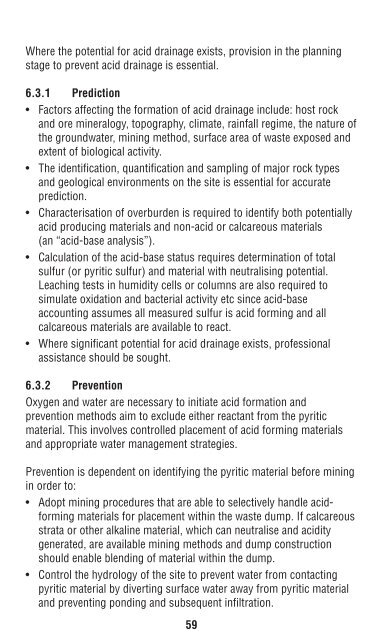Mine Rehabilitation Handbook - Mining and Blasting
Mine Rehabilitation Handbook - Mining and Blasting
Mine Rehabilitation Handbook - Mining and Blasting
Create successful ePaper yourself
Turn your PDF publications into a flip-book with our unique Google optimized e-Paper software.
Where the potential for acid drainage exists, provision in the planning<br />
stage to prevent acid drainage is essential.<br />
6.3.1 Prediction<br />
• Factors affecting the formation of acid drainage include: host rock<br />
<strong>and</strong> ore mineralogy, topography, climate, rainfall regime, the nature of<br />
the groundwater, mining method, surface area of waste exposed <strong>and</strong><br />
extent of biological activity.<br />
• The identification, quantification <strong>and</strong> sampling of major rock types<br />
<strong>and</strong> geological environments on the site is essential for accurate<br />
prediction.<br />
• Characterisation of overburden is required to identify both potentially<br />
acid producing materials <strong>and</strong> non-acid or calcareous materials<br />
(an “acid-base analysis”).<br />
• Calculation of the acid-base status requires determination of total<br />
sulfur (or pyritic sulfur) <strong>and</strong> material with neutralising potential.<br />
Leaching tests in humidity cells or columns are also required to<br />
simulate oxidation <strong>and</strong> bacterial activity etc since acid-base<br />
accounting assumes all measured sulfur is acid forming <strong>and</strong> all<br />
calcareous materials are available to react.<br />
• Where significant potential for acid drainage exists, professional<br />
assistance should be sought.<br />
6.3.2 Prevention<br />
Oxygen <strong>and</strong> water are necessary to initiate acid formation <strong>and</strong><br />
prevention methods aim to exclude either reactant from the pyritic<br />
material. This involves controlled placement of acid forming materials<br />
<strong>and</strong> appropriate water management strategies.<br />
Prevention is dependent on identifying the pyritic material before mining<br />
in order to:<br />
• Adopt mining procedures that are able to selectively h<strong>and</strong>le acid-<br />
forming materials for placement within the waste dump. If calcareous<br />
strata or other alkaline material, which can neutralise <strong>and</strong> acidity<br />
generated, are available mining methods <strong>and</strong> dump construction<br />
should enable blending of material within the dump.<br />
• Control the hydrology of the site to prevent water from contacting<br />
pyritic material by diverting surface water away from pyritic material<br />
<strong>and</strong> preventing ponding <strong>and</strong> subsequent infiltration.<br />
59<br />
• Isolate the pyritic material from water by placing it above the water<br />
table <strong>and</strong> capping with clay or other impermeable materials. The cap<br />
can then be covered with soil <strong>and</strong> vegetation established (see section<br />
6.2.20). This technique reduces infiltration <strong>and</strong> leaching. In practice it<br />
is very difficult to completely isolate pyritic spoils from water contact.<br />
Unlike tailings storage areas, waste dumps are unlikely to have an<br />
impermeable or semi-impermeable base or sides. The task of<br />
reshaping <strong>and</strong> encapsulation is consequently greater <strong>and</strong> more costly.<br />
• Submerge the acid-forming material; this can be an effective strategy<br />
where sufficient water is available (see section 6.2.2). It has been<br />
suggested that a water cover sufficient to maintain the partial<br />
pressure of oxygen below 1% is necessary to inhibit pyrite oxidation.<br />
6.3.3 Treatment<br />
Treatment procedures for dealing with acid leachates will vary according<br />
to site conditions. Treatment methods previously adopted or under trial<br />
include the following:<br />
• Incorporation of lime (or other neutralising materials) into the surface<br />
of waste dumps. Neutralising capacity of the available material <strong>and</strong><br />
the “lime dem<strong>and</strong>” of the dump should be tested to determine<br />
feasibility (refer 5.5.1 <strong>and</strong> 6.2.2).<br />
• Channeling run-off from the dump to selected recharge areas i.e.<br />
ditches filled with alkaline material or areas of the dump where<br />
selected material with high neutralising capacity has been placed.<br />
• Injection of neutralising fluids e.g. sodium carbonate, anhydrous<br />
ammonia or caustic soda into mine dumps to intercept flow paths of<br />
acid drainage.<br />
• Collection of acid drainage downstream for chemical treatment or inline<br />
aeration.<br />
• Directing acid drainage to artificial wetl<strong>and</strong>s where biological<br />
production of bicarbonate neutralises the acidic drainage. Metals are<br />
removed through hydrolysis <strong>and</strong> biological formation of insoluble<br />
sulfides <strong>and</strong> carbonates.<br />
• In areas where evaporation consistently exceeds precipitation,<br />
disposal by evaporation may be feasible. Safe disposal of sludge with<br />
elevated levels of heavy metals <strong>and</strong> salts is then required.<br />
• Controlling the bacteria Thiobacillus ferrooxidans in situations where<br />
it plays a significant role in accelerating acid formation.<br />
60
















